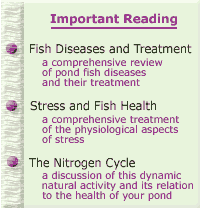 |
| 15c. Common Fish Diseases |
|
|
|
We've described below several of the most common pond fish diseases and problems to watch out for. Always observe your fish carefully. Familarity with 'normal' behavior and habits will give you a quick indication when there may be problems with your fish. Recurrent water quality problems that foster disease should be dealt with and eliminated.
A more comprehensive look at fish health and disease, including Koi Ulcer Disease can be found in Fish Diseases and Treatment. This section includes common treatments as well as advanced protocols in managing pond fish disease.
Symbols that appear beside the name of the disease are color-coded to the suggested medications that follow in the next solution, Solution 15d.
|
|
 |
|
|
 |
| This protozoan parasite appears as many white spots on the fish's body when the parasite is in the encysted stage of its lifecycle. The lifecycle of the parasite can be quite long at the lower temperatures in your pond. Retreatment should be administered 4-7 days after the parasites are no longer visible. |
| |
 |
| These large crustaceans are visible to the eye and cause weakened fish. The wounds they cause can become infected by secondary pathogens. These parasites should be removed with tweezers and the remaining wound treated with a topical solution of diluted mercurochrome. Following this, the pond should be treated to kill remaining parasites. |
| |
 |
| This can be caused by poor water quality, internal problems, and malnutrition. Water quality should be improved with filtration. See nutrition section to set up the proper nutrition schedule. |
| |
 |
| Dropsy is characterized by a bloated appearance and protruding scales. The cause can be many different internal problems that are usually not contagious. Treatment only helps about 50% of the time. |
| |
 |
| Bacterial problems will present as ulcers, red patches and white slime-like areas on fish. Fish exhibit diminished appetite and are listless, often hanging near the bottom or hiding among rocks or other cover. |
| |
 |
| This is generally caused by poor water quality and stress resulting from a bacterial infection. The fin will regrow and pigment will be restored in a few months. Water quality should be increased with filtration. |
| |
 |
| This secondary infection can kill fish if left untreated. Mouth fungus, reddened lips, and cotton-like growths are symptoms of fungal infections. |
|
•• We cannot be responsible for fish loss due to treatments outlined on this site.
We encourage you to buy healthy livestock from reputable dealers, observe fish carefully at regular intervals and test your water frequently for problems.
Prevention is always your first line of defense against disease. ••
|
|
 |
|
|

